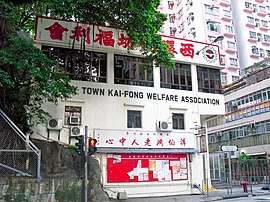Kaifong associations
Kaifong associations (Chinese: 街坊會) or kaifong welfare associations (Chinese: 街坊福利會) are traditional mutual aid organizations which emerged in Hong Kong after the Second World War. They were set up with the help of the Secretariat for Chinese Affairs, particularly the Society Welfare Council, of the British colonial government, which had the intention of developing non-governmental civil society for the purpose of promoting moderate politics among the general public.[1] The term kaifong is a Cantonese romanisation of the Chinese 街坊, which means people living in the same neighbourhood, and kaifong associations mainly aim at serving the residents of specific neighbourhoods.

The main purpose was to provide low cost or free services in areas such as education and health care for the many refugees from China. By 1958, there were twenty-one; by 1958, twenty-eight.[1] After 1958, the government tried to use the kaifong associations to communicate with the local population. In 1960, kaifong associations extended their services to areas such as legal support or environmental protection.
After the introduction of the District Offices in 1969, the importance of kaifong associations declined. Nevertheless, many kaifong associations remain active today.
List
- Aberdeen Kai-fong Welfare Association
- Chai Wan Resettlement Kaifong Welfare Association
- Cheung Sha Wan Kaifong Welfare Association
- Chuk Yuen Cottage Area Kaifong Welfare Advancement Committee
- Mongkok Kaifong Association
- Sham Shui Po Kaifong Welfare Advancement Association
- Tai Hang Sai Kaifong Welfare Association
- Tsim Sha Tsui Kaifong Welfare Association
- Wang Tau Hom Resettlement Kaifong Welfare Association
- Yaumati Kaifong Welfare Advancement Association
References
- Hegemonies Compared, ch. "State Formation in Hong Kong," sec. the Cold War & the Communist Takeover of China in 1949, subsec. State Power & the Third Sector in Colonial Society, p.107
Further reading
- The Kaifong Associations and the Society of Hong Kong. Aline K. Wong (1972). Taipei: Orient Cultural Service. ISBN 0-89986-042-7.
- Society and Politics in Hong Kong. Lau Siu-kai (1982). Hong Kong: Chinese University Press. ISBN 9622012817.
| Wikimedia Commons has media related to Kai fong associations in Hong Kong. |